Le 3 décembre 2020, lors de notre prestigieuse vente d’instruments de musique des grands maîtres, Vichy Enchères présentait pas moins de six archets de François Xavier Tourte, aussi connu sous le nom de Tourte le Jeune. La réunion d’autant d’archets du maître – habituellement rares sur le marché – au sein d’une même vente, est tout à fait exceptionnelle. Outre ce nombre inouï, la qualité des archets est absolument remarquable. Ces six exemplaires permettent de retracer à merveille les innovations mises au point par ce célèbre archetier considéré comme l’inventeur de l’archet moderne. L’occasion de revenir sur l’histoire de celui qui fut pour l’archet, ce que Stradivarius fut pour le violon.
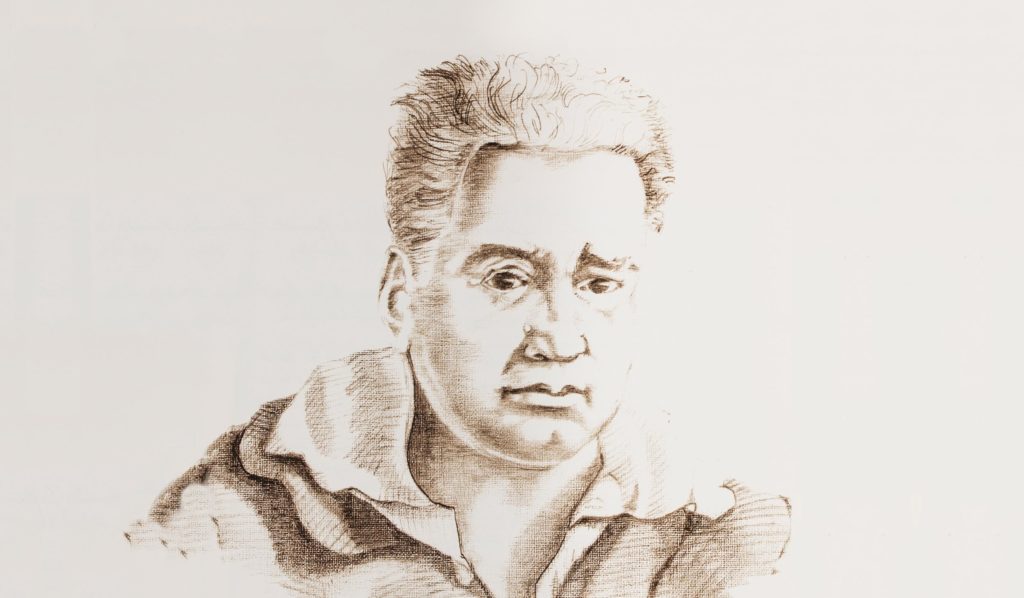
Comme il est fréquent dans ce domaine, François Xavier Tourte est issu d’une dynastie d’archetiers. Il est le fils cadet du renommé Nicolas Pierre Tourte (vers 1700-1764), et le frère de Nicolas Léonard Tourte (1746-1807) – dont un archet sera également mis en vente le 3 décembre. C’est pourtant en tant qu’horloger que François Xavier débute sa carrière. Cet artisanat de prestige lui conférera la maîtrise, après six ans d’apprentissage et huit années d’exercice, du travail des métaux précieux et des mécaniques de précision – autant de savoir-faire communs à l’archetier. Ainsi, probablement en 1774, il quitte l’horlogerie afin de rejoindre son frère.
Commence alors une collaboration et un partage de compétences fructueux. François Xavier s’installe rue des Chantres afin d’échapper aux règlements des corporations, comme l’avait fait avant lui son frère en s’établissant dans l’enceinte de l’hospice des Quinze-Vingts. Ils réalisent ensemble de nombreux modèles “Cramer” tout en continuant leurs recherches sur les qualités des différentes essences de bois. En résulte l’utilisation généralisée, à partir des années 1780, du pernambouc – conférant “rigidité, nervosité, élasticité et beauté”[1] aux archets.
[1] Bernard Millant, Jean-François Raffin, L’Archet, T.1, L’Archet Editions, 2000, p.122.
Une rencontre va donner un nouveau tournant à la carrière de François Xavier : celle du violoniste Jean-Baptiste Viotti. Les frères, qui jouissent déjà d’une certaine réputation, sont contactés par le virtuose en 1782. Ce dernier souhaite perfectionner sa pratique au moyen d’un archet dont le jeu serait “identique du talon jusqu’à la pointe”[2]. C’est à François Xavier qu’il va finalement confier tout particulièrement la mission. Après beaucoup d’essais, celui-ci parvient à satisfaire les attentes du musicien en faisant considérablement évoluer l’archet baroque. La baguette s’allonge, le cambre devient davantage concave, tandis qu’est donnée – aussi bien à la hausse qu’à la tête – la même hauteur. Il s’agit d’une révolution dans l’histoire de l’archèterie. En effet, bien que ces dispositifs nous soient aujourd’hui familiers, ils étaient tout à fait novateurs à l’époque.
Après Viotti, c’est l’illustre Rodolphe Kreutzer, un autre violoniste insatisfait de son archet, qui va amener François Xavier à faire évoluer l’instrument. Cette rencontre débouche sur la création de la “virole” – aussi appelée “passant”, en 1782-1783. Perfectionniste, le facteur met au point un système de recouvrement en nacre pour cacher le crin – donnant ainsi naissance à ce qu’on nomme une “hausse à recouvrement”. Pour améliorer la sonorité du violon, la taille et le poids des modèles sont peu à peu normalisés. Dès lors, ce travail en relation étroite avec les musiciens a permis à François Xavier de transformer l’archet.
[2] Bernard Millant, Jean-François Raffin, L’Archet, T.1, L’Archet Editions, 2000, p.122.
La révolution française éclatant, les sympathies soupçonnées de Léonard envers la royauté le contraignent à s’effacer. A contrario, François Xavier, dont la position semble plus neutre, profite de la suppression des corporations en 1791 pour développer sa production. C’est à cette époque que le maître va véritablement devenir “le symbole de la nouvelle archèterie française”[3]. En effet, jusqu’en 1800, il n’aura de cesse d’améliorer les baguettes. Les têtes s’embellissent et s’affinent. En ce qui concerne les violoncelles, le modèle de tête à “col de cygne” apparaît. La fin du XVIIIème siècle voit ainsi la naissance de ce qu’on pourrait appeler “l’archet moderne”.
Cette fois-ci, les dimensions et le poids – qu’il s’agisse du violon, de l’alto ou du violoncelle – sont fixés. En 1800, François Xavier obtient enfin le premier document officialisant son titre de “facteur d’archets”, lui permettant de s’installer au 10 Quai de l’École de Paris. Toujours en quête de perfection, il continuera toute sa vie ses expérimentations, jusqu’à donner aux hausses leur forme idéale :
“La baguette définitive est née ; elle va révolutionner toute l’archèterie, tant française qu’étrangère. Elle sera imitée par les Écoles européennes et, au XXe siècle, dans le monde entier.”[4]
[3] Bernard Millant, Jean-François Raffin, L’Archet, T.1, L’Archet Editions, 2000, p.123.
[4] Ibid, p.125.
François Xavier Tourte meurt à l’âge de 87 ans, le 25 avril 1835 à Paris. Si la personne disparaît, il n’en est rien de sa renommée et de son influence. Un an après sa mort, le luthier parisien Charles François Gand demandera d’ailleurs à Étienne Pajeot – archetier de Mirecourt – de restaurer “dans les moindres détails” une baguette du “grand Maître”. De fait, celui qui est considéré comme le “Stradivarius de l’archet” a marqué les générations après lui – et ce jusqu’aux plus contemporaines.
La perfection de ses créations continue à enchanter, si bien que l’instrument a peu évolué depuis. En atteste le record mondial pour un archet détenu par un instrument de François Xavier Tourte ! Réalisé à Vichy Enchères le 30 novembre 2017, il s’est vendu 576.600 euros.
Un record qui, au terme de ce bref détour historique, prend davantage de sens, et qui pourrait encore être éclairé par ces quelques lignes issues de l’ouvrage de référence de Bernard Millant et Jean François Raffin :
Certaines innovations furent apportées, d’autres modèles créés, mais l’archet de François TOURTE reste et restera l’élément de comparaison absolu et un modèle étalon pour les archetiers actuels et à venir. C’est la raison pour laquelle l’ensemble de son œuvre est si recherché dans le monde musical par les grands musiciens professionnels et par tous les collectionneurs avertis.
Bernard Millant, Jean-François Raffin, L’Archet, T.1, L’Archet Editions, 2000, p.128
François Xavier est le fils cadet d’une famille d’archetiers, son frère Nicolas Léonard, aîné de seulement deux ans, est un archetier talentueux qui épaule rapidement leur père. Malgré cela, de son côté, François Xavier suivra une formation longue en horlogerie. Il sera l’un des rares archetiers à avoir connu la transition complète de l’archet. Du baroque au moderne en passant par le classique, c’est l’acteur le plus marquant de cette évolution.
Lors de la vente du 3 décembre, nous aurons la chance de profiter de 6 exemplaires qui marquent clairement l’évolution de son travail. 1775 pour le plus ancien, lorsqu’il commence à travailler avec son frère, à 1820 pour le plus récent, en plein âge d’or…. alors qu’il a 72 ans.
Archet de violon de François Xavier TOURTE
Prix confidentiel
Violin bow by François Xavier TOURTE
confidential price
Cet exemplaire, que l’on situe vers 1775, est un travail de la toute première époque. Son père est décédé depuis 11 ans et c’est son frère qui continue la tradition familiale. Cela fait donc un an que la fratrie travaille ensemble et nous ressentons dans cet archet l’influence de Nicolas Léonard.
Rares sont les archets de cette époque à bénéficier des nouveautés telles que le passant, cette bague sur la hausse, pour mieux maintenir les crins de la mèche. Le bouton plein est en argent et garantit plus de résistance que les boutons en os ou ivoire cassant trop facilement avec le temps. Comme la plupart des archets classiques de la famille, la hausse est en ivoire. C’est sur une hausse comme celle-ci que nous avons trouvé le passant le plus ancien sur un archet de cet auteur. La largeur de crin est étroite mais un peu plus large que les archets dit « Classiques ». La tête est haute, élégante, avec un retour en arrière, elle est encore bien inspirée des modèles « Cramer ». Cet archet fait partie de la première période de l’évolution de l’archet classique au moderne.
De l’époque 1790-1795, nous avons à la vente deux exemplaires remarquables. François Xavier a alors plus de 40 ans et a longtemps collaboré avec son frère mais commence à affirmer son indépendance. L’affiliation reste néanmoins encore présente et l’on sent bien sur ces deux archets que la transition entre « classique » et « moderne » est aboutie.
Les hausses en ébène ont de profonds dégorgements très ouverts, et sont décorées d’écussons ou grandes pastilles de nacre. Les baguettes sont maintenant plus fermes, de section ronde, leur jeu devient beaucoup plus moderne. La largeur de mèche s’élargit. Le travail est fin et élégant avec des lignes encore très rondes et délicates.
Archet de violoncelle de François Xavier TOURTE
166 160 €
Cello bow by François Xavier TOURTE
€166,160
Il est signé « TOURTE » de la marque de son frère Nicolas Léonard sur laquelle le « L » et le losange ont été enlevés. Il ne signera de cette manière que sur une très courte période.
La tête, arrondie sur le devant comme sur l’arrière, est aujourd’hui un modèle bien connu sous le nom de « col de cygne ». Elle ne comporte donc pas les chanfreins si particulier de ce maître. Il consacrera cette découpe particulière uniquement aux archets de violoncelle.
Archet de violon de François Xavier TOURTE
43 400 €
Violin bow by François Xavier TOURTE
€43,400
L’écusson de François Xavier est ouvert et typique. La plaque de tête en argent nous semble, elle, postérieure. Il y a beaucoup de points communs entre ces deux archets : l’orientation et la géométrie de la tête, les proportions de la hausse et la presque similitude des boutons.
Les chanfreins de tête sont couchés sur l’extérieur et forment une virgule au niveau de la plaque que l’on retrouve de manière presque systématique chez cet auteur.
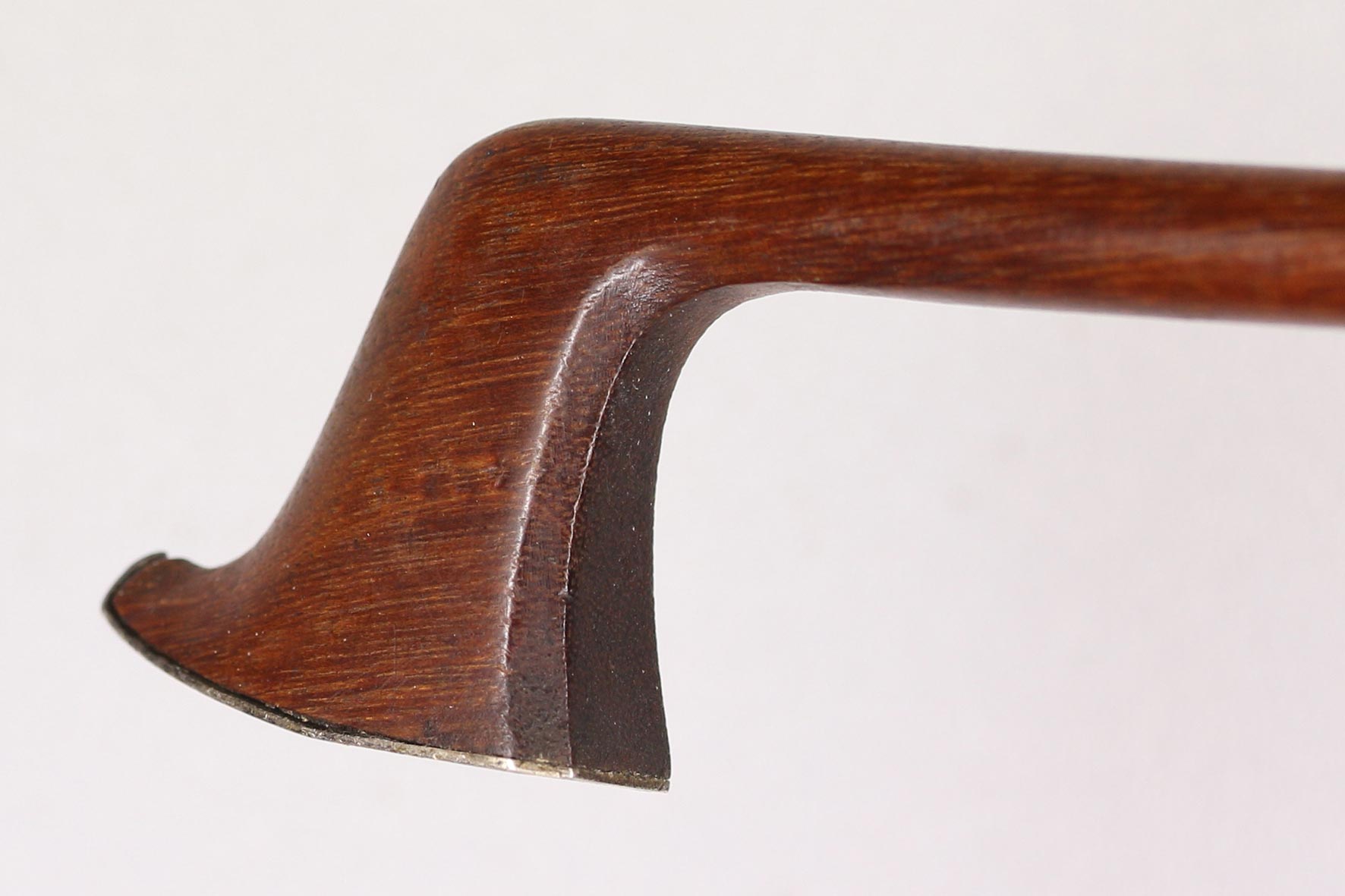
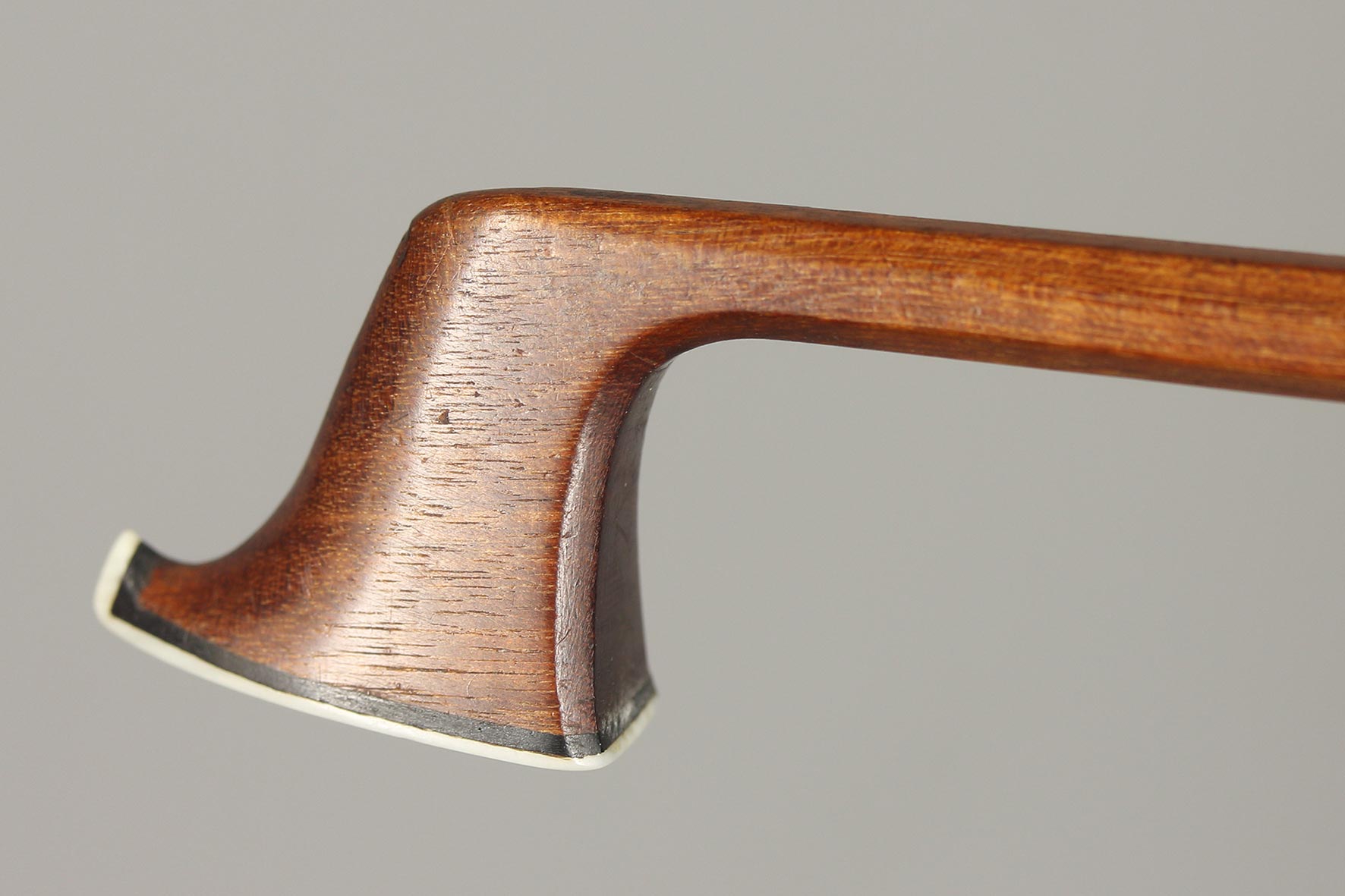
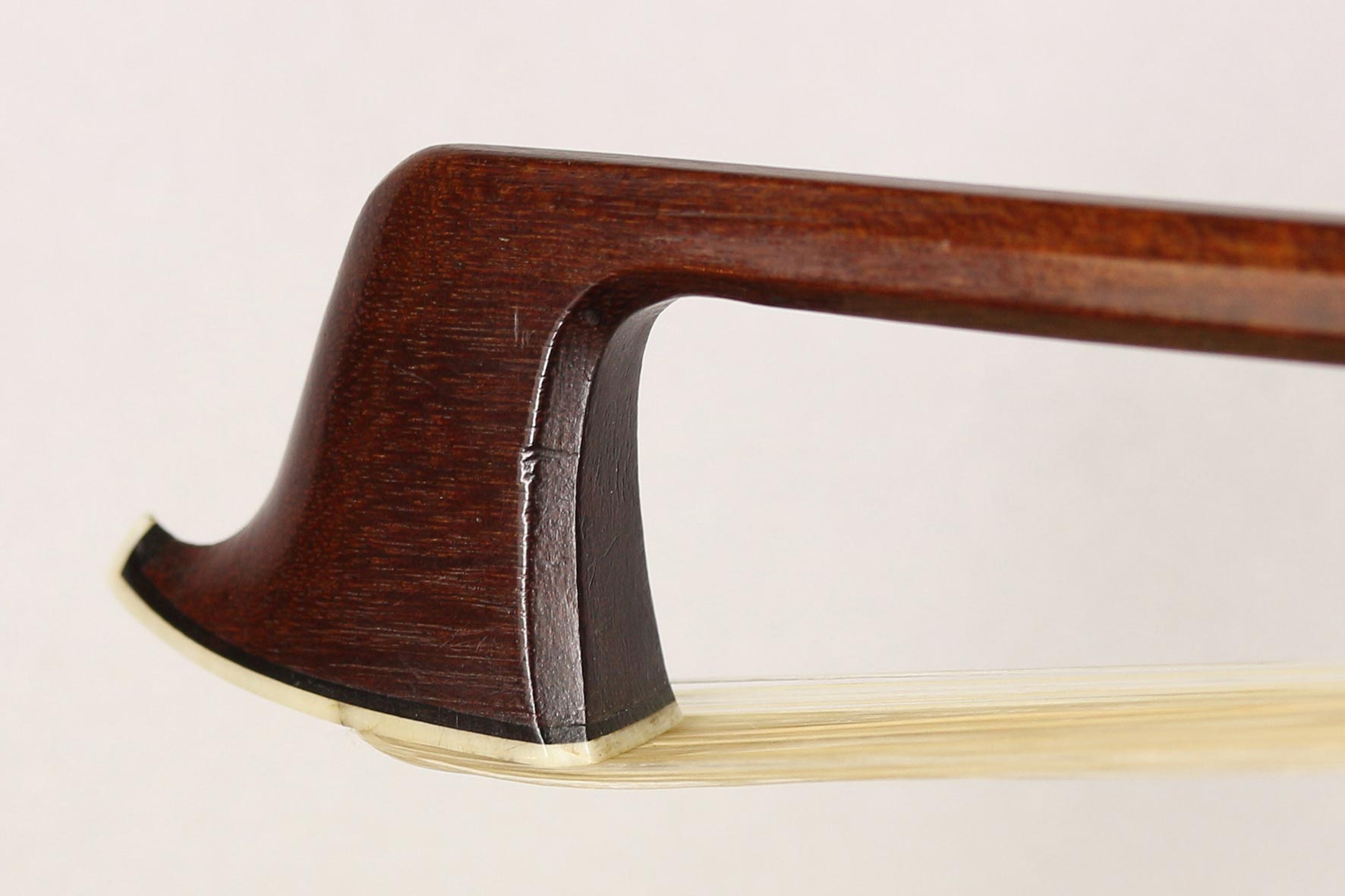
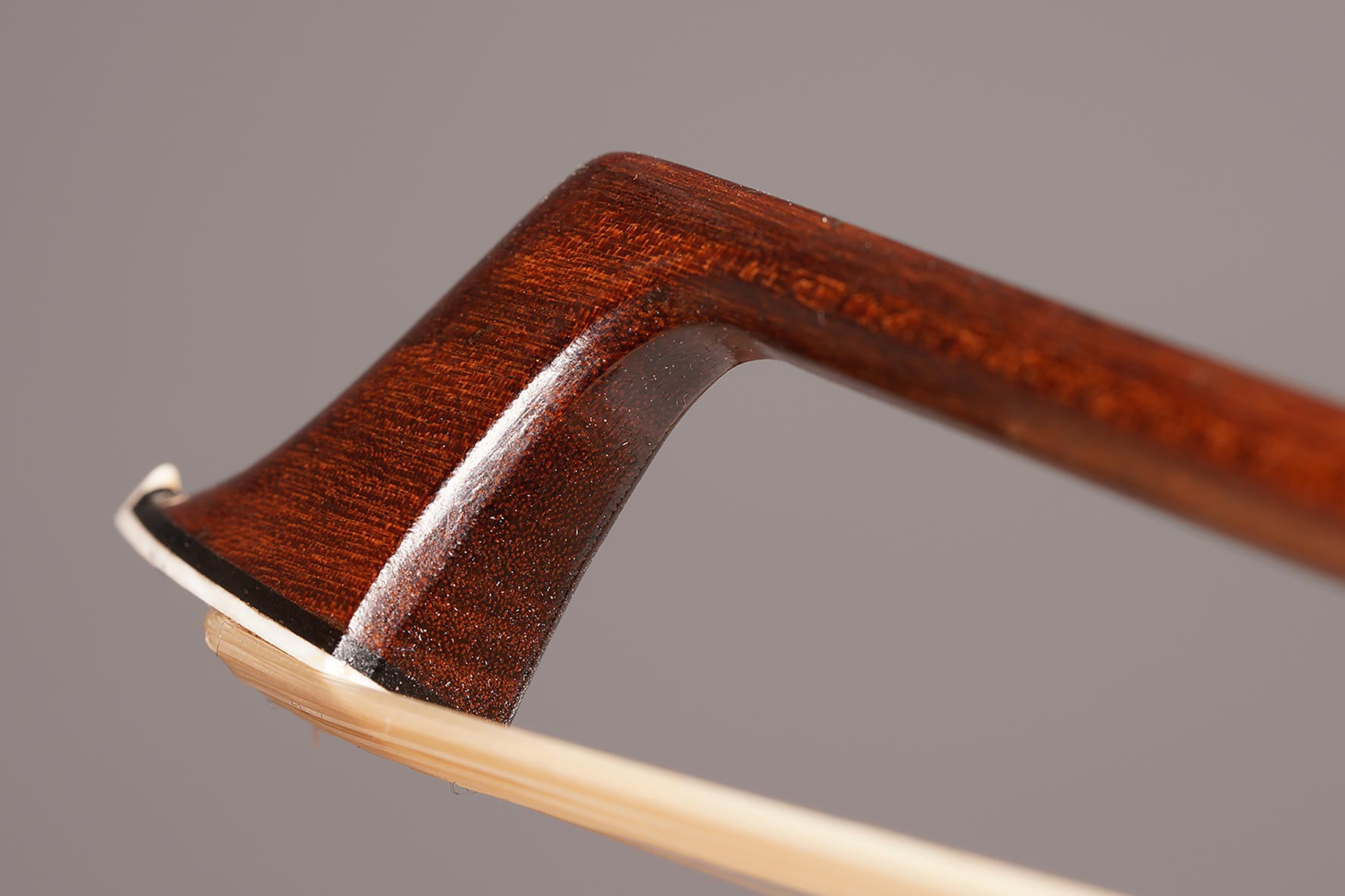
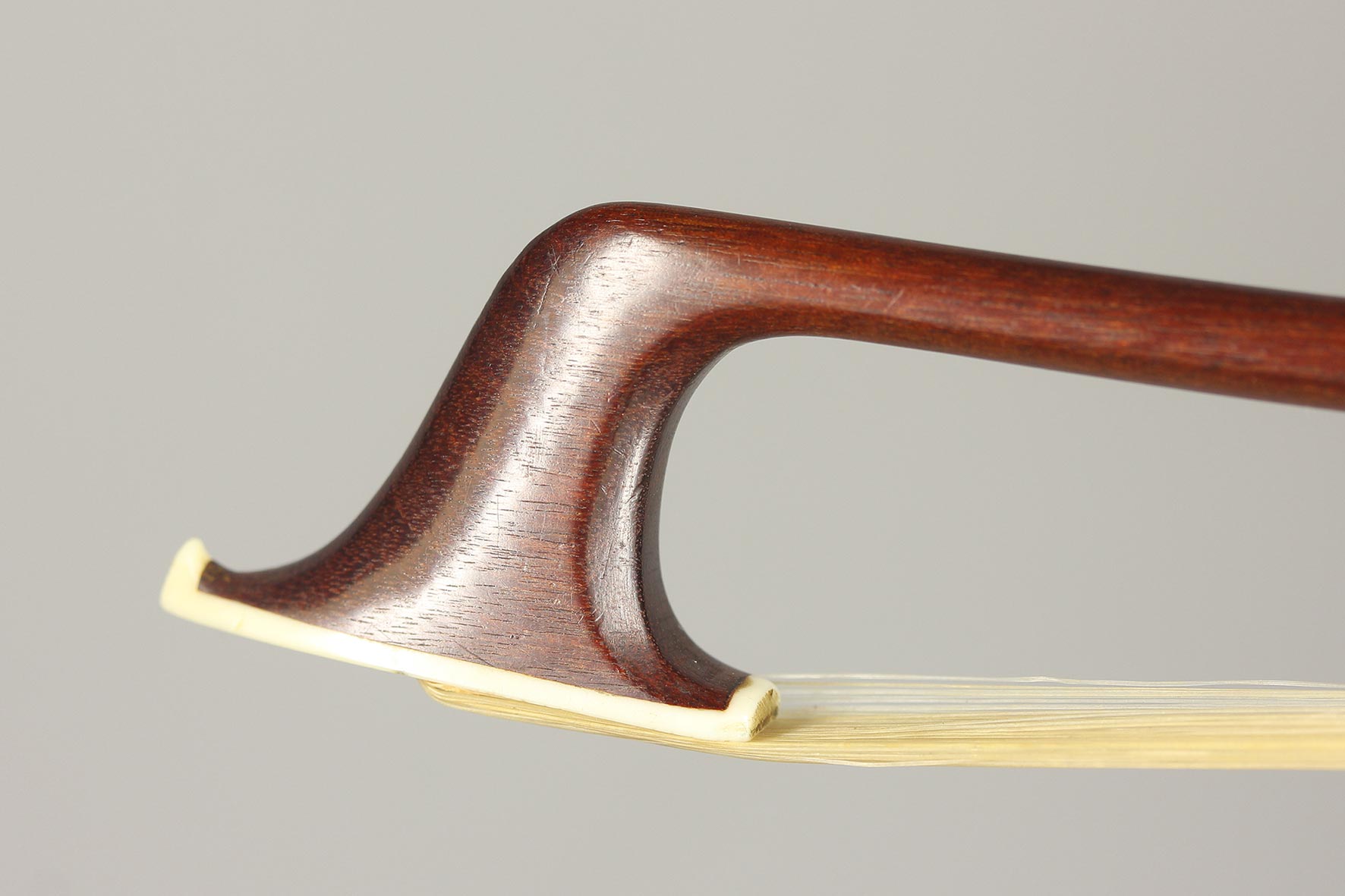
Archet de violon de François Xavier TOURTE
Prix non divulgué
Violin bow by François Xavier TOURTE
Price not available
C’est l’une des pièces majeures de ce maître, réalisé entre 1800 et 1810, cet archet est dans un état de fraîcheur rare et nous apporte ainsi de nombreux détails à étudier. La baguette, fine, est de section octogonale – forme qu’il adopte vers 1795-1800. Par la suite, la majorité de ses archets le sera. Le modèle de tête devient plus massif tout en restant assez rond. Les chanfreins de tête sont plus fins et élégants et donnent une impression de force et de finesse. Le dégorgement de hausse est plus court et moins ouvert. Les hausses sont plus compactes et solides. Nous ressentons dans cette évolution la volonté d’améliorer la pérennité de ses réalisations.
Baguette d’archet de violon de François-Xavier TOURTE
132 680 €
Violin bow stick by François-Xavier TOURTE
€132,680
Cet archet est un beau témoignage du début de sa période « d’or » : le modèle de tête est de plus en plus masculin, la baguette est octogonale sur cet exemplaire et l’équilibre entre fermeté et flexibilité atteint un niveau qui inspirera beaucoup d’archetiers qui chercheront à s’en approcher le plus possible. François Xavier Tourte est, à partir de cette époque, au sommet de son art.
Baguette d’archet de violoncelle de François Xavier TOURTE
73 160 €
Cello bow stick by François Xavier TOURTE
€73,160
En 1820, François Xavier TOURTE a 72 ans et est bien installé dans sa plus belle période. Il est impressionnant, même de nos jours, d’imaginer rester à un tel niveau à cet âge, d’autant plus qu’il faudra attendre une bonne dizaine d’années avant de percevoir quelques imprécisions dans son travail. La baguette, également octogonale, est fine avec un beau bois brun foncé. La hausse et le bouton ont été réalisés spécialement pour cet archet.
Il n’y aura dès lors plus d’évolution dans son travail. Il aura établi une référence que les archetiers contemporains essayent de reproduire depuis plus de 200 ans…
Un texte de Yannick Le Canu et Sylvain Bigot pour le Cabinet d’Archetiers Experts Jean-François Raffin / Vichy Enchères
© Christophe DARBELET
On 3rd December, Vichy Enchères’ prestigious sale of musical instruments by the great masters will include no fewer than six bows by François Xavier Tourte, also known as Tourte “le Jeune”. The inclusion of so many bows by this master in a single sale is exceptional, as they are usually so rare on the market. It is not only their quantity but also their remarkable quality that is extraordinary. These six examples allow us to retrace precisely the innovations introduced and perfected by this famous bowmaker, who is generally considered to be the inventor of the modern bow. It is an opportunity to revisit the history of the “Stradivarius of the bow”.

As was often the case in this trade, François Xavier Tourte came from a dynasty of bowmakers. He was the eldest son of the renowned Nicolas Pierre Tourte (c.1700 – 1764), and the brother of Nicolas Léonard Tourte (1746 – 1807), a bow by whom is also included in the sale on 3rd December. However, it was as clockmaker that François Xavier started his career. After six years of apprenticeship and eight more years in the profession, this prestigious craft allowed him to master the skills required to work precious metals and precision mechanical engineering, both of which are essential in bowmaking as well. And so, probably in 1774, he left clockmaking to join his brother, which marked the start of a new and fruitful collaboration and sharing of skills.
François Xavier settled in rue des Chantres in order to avoid the reach of the guilds, as had done his brother before him when he settled in the courtyard of the Hospice des Quinze-Vingts. Together they produced many “Cramer” models, whilst continuing their research on the qualities of various types of wood. This led, from the 1780s, to the widespread use of pernambuco, which confers “strength, responsiveness, elasticity and beauty”[1] to bows.
[1] Bernard Millant, Jean-François Raffin, L’Archet, T.1, L’Archet Editions, 2000, p.122.
François Xavier’s career took a new turn after an encounter with the violinist Jean-Baptiste Viotti. The brothers, whose reputation was already well established, were contacted by the virtuoso in 1782. He wanted to improve his playing by means of a bow whose play would be “identical from the heel to the tip”[2]. It is François Xavier in particular who was tasked with this mission. After numerous experiments, he succeeded in satisfying the musician’s expectations by modifying considerably the baroque bow. The shaft was lengthened, the camber made concave, whilst the head and the handle were levelled in height. This was nothing short of a revolution in bowmaking, and whilst all these elements are familiar to us today, they were completely new at the time.
After Viotti, it was the illustrious Rodolphe Kreutzer, another violinist dissatisfied with his bow, who encouraged François Xavier to innovate further. Their meeting led to the advent of the ferrule in 1782/1783. This perfectionist bowmaker introduced a further improvement with a device made from mother-of-pearl designed to cover the hair under the frog, thus creating what is now known as the “pearl slide”. In order to enhance the violin tone, the length and weight of bows were gradually normalized. As such, François Xavier’s close relationship with musicians allowed him to transform the bow.
[2] Bernard Millant, Jean-François Raffin, L’Archet, T.1, L’Archet Editions, 2000, p.122.
After the French Revolution broke out, Léonard’s suspected sympathy for the royal cause forced him to step aside. Meanwhile, François Xavier, whose politics seemed more neutral, took advantage of the guilds’ dissolution to increase his production. It is around that time that the master truly became “the symbol of the new French bowmaking” (3). Indeed, until 1800, he made continuous improvements to his sticks. The heads became finer and more beautiful. The “swan neck” heads made their first appearance on cello bows. As a result, the end of the 18th century saw the birth of what can be described as the “modern bow”.
It was also at this time that the length and weight of violin, viola and cello bows were finally set. In 1800, François Xavier finally obtained the documentation required for him to be officially called “bow maker”, which allowed him to move to 10 quai de l’École de Paris. He continued his quest for perfection throughout the rest of his life, carrying out further experiments, until he arrived at the frog’s perfect form:
“The ultimate stick was born; it revolutionized bowmaking, in France and elsewhere. It was copied by other European schools and, in the 20th century, by the rest of the world.”[4]
[3] Bernard Millant, Jean-François Raffin, L’Archet, T.1, L’Archet Editions, 2000, p.123.
[4] Ibid, p.125.
François Xavier Tourte died at the age of 87, on 25 April 1835 in Paris. Although the man himself was gone, his fame and influence would be long lived. One year after his death, the French violin maker Charles François Gand asked Etienne Pajeot – the bowmaker in Mirecourt – to restore “in the most minute details” a stick by the “great master”. It illustrates how the man who is considered the “Stradivarius of the bow” made a lasting impression on the generations of bow makers that came after him, up to and including contemporary bowmakers.
His perfect creations continued to delight, so much so that the bow form has evolved very little since his death. The price achieved at an auction by a François Xavier Tourte bow, a world record, also attests to this: the auction was held on 30 November 2017 by Vichy Enchères, and it sold for 576.600 euros!
In light of our brief historical journey, this record is easier to understand, and these few words extracted from the reference volume by B. Millant and J.F. Raffin might shed further light on this:
Certain innovations were introduced, other models created, but the François TOURTE bow is and will remain the ultimate point of reference, and the gold standard for current and future generations of bowmakers. It is the reason why his output is so sought after in the musical world by the greatest professional musicians and erudite collectors.
Bernard Millant, Jean-François Raffin, L’Archet, T.1, L’Archet Editions, 2000, p.128
François Xavier was the eldest son in a bowmaking family, and his brother Nicolas Léonard, his junior by a mere two years, was a talented bowmaker who quickly became their father’s assistant. Meanwhile, separately, François Xavier pursued a long apprenticeship in clockmaking. He is one of the few bowmakers who experienced firsthand the complete transition of the bow, from baroque to modern via the classical form, and he became the most important figure in this evolution.
The sale on 3rd December will provide an opportunity to examine six bows that clearly highlight the evolution of his work. The oldest is from 1775, when he started working with his brother, and the most recent from 1820, when he was at the height of his powers, then aged 72.
Archet de violon de François Xavier TOURTE
Prix confidentiel
Violin bow by François Xavier TOURTE
confidential price
This example, which is dated circa 1775, is a work from his very early period. His father had died 11 years earlier, and his brother was the one perpetuating the family tradition. The brothers had been working together for a year by the time this bow was made, and the influence of Nicolas Léonard can be felt.
Bows that were already fitted with such innovations as the ferrule, the ring on the frog that provides a tighter grasp of the hair, were rare at the time. The whole button is made of silver, a longer lasting material than bone or ivory, which often used to break over time. As with most other classical bows from this family, the frog is of ivory. It is on a frog such as this one that the oldest ferrule by this maker was found. The width of the hair is narrow, but slightly wider than on bows of the “classical” period. The head is tall and elegant, with a turn at the back, and still deeply rooted in the “Cramer” models. This bow is from the first period of evolution, between the classical and the modern bow.
Two remarkable examples from the period 1790 – 1795 are included in the sale. François Xavier was then over 40 years old and, after a long collaboration with his brother, was starting to affirm his independence. However, the signs of their association are still present, and the complete transition from “classical” to “modern” bow can now be seen.
The frogs, of ebony, have very open and deep throats, and are decorated with badges or large pearl eyes. The sticks are also stiffer, with a round cross-section, and their play became much more modern. The width of the hair is greater. The work more generally is fine and elegant, with lines that are still soft and delicate.
Archet de violoncelle de François Xavier TOURTE
166 160 €
Cello bow by François Xavier TOURTE
€166,160
It is stamped “TOURTE” using the stamp from his brother Nicolas Léonard from which the “L” and the diamond-shape have been removed. He only stamped his bows in this way for a very short period. The head, which is rounded off at the front as well as the back, is the well known model referred to today as “swan neck”, and therefore does not include the chamfers so distinctive of this maker. He only ever cut heads in this style for cello bows.
Archet de violon de François Xavier TOURTE
43 400 €
Violin bow by François Xavier TOURTE
€43,400
The badge of François Xavier is open and characteristic. The silver facing appears to have been added later. There are many similarities between the two bows: the orientation and geometry of the head, the proportions of the frog, and the nearly identical buttons.
The chamfers of the head are angled towards the outside and form a comma at the facing, a characteristic shape almost always present with this maker.





Archet de violon de François Xavier TOURTE
Prix non divulgué
Violin bow by François Xavier TOURTE
Price not available
This is one of the masterpieces by this master, made between 1800 and 1810, and it is in a rare state of preservation that allows us to study a number of its details. The thin stick is octagonal, a shape he adopted around 1795/1800. From then on, most of his bows were of this type. The model for the head became more substantial, whilst retaining some roundness. The chamfers of the head are smaller and more elegant, and give the impression of strength and finesse at the same time. The frog throat is neither as deeply cut nor as open. The frogs are more solid and compact. One can sense in these changes a desire by the maker to make his creations longer lasting.
Baguette d’archet de violon de François-Xavier TOURTE
132 680 €
Violin bow stick by François-Xavier TOURTE
€132,680
This bow is a great example from the beginning of his “golden period”: the model for the head is increasingly “masculine”, the stick is octagonal on this example, and the balance between its strength and flexibility set the standard that many bowmakers have attempted to come close to since then. From this point on, François Xavier Tourte was at the height of his powers.
Baguette d’archet de violoncelle de François Xavier TOURTE
73 160 €
Cello bow stick by François Xavier TOURTE
€73,160
In 1820, François Xavier Tourte was 72 years old and well into his best period. It is impressive, even by today’s standard, to imagine this maker working to such a high level at that age, in particular considering it took at least another 10 years for some imprecisions to start appearing in his work. This stick, also of octagonal cross-section, is thin and of a handsome dark brown shade. The later frog and button were made specifically for this bow.
This marked the end in the evolution of his work. By then, he had established the gold standard that all bowmakers that came after him, including contemporary bowmakers, have attempted to replicate for the last 200 years…
An article by Yannick Le Canu and Sylvain Bigot for the Cabinet d’Archetiers Experts Jean-François Raffin / Vichy Enchères
© Christophe DARBELET
Translation by Marc BUTTERLIN